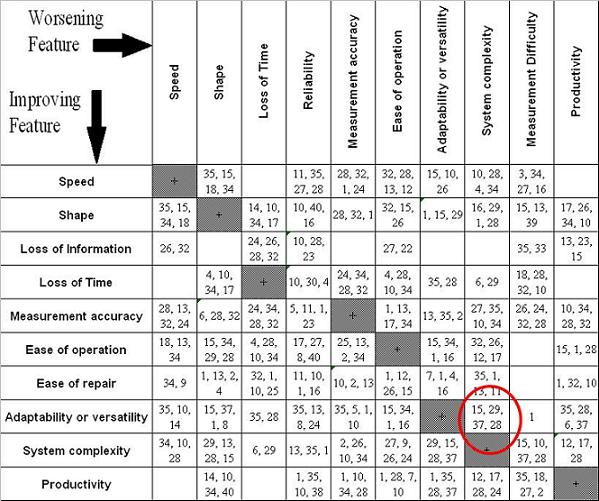Resolving Contradictions with 40 Inventive Principles
By Ellen Domb
Innovation practitioners can all benefit from one of the basic concepts of the Theory of Inventive Problem Solving (TRIZ). The father of TRIZ, Genrich Altshuller, deserves credit for the insight that at the heart of many problems is a contradiction, and that much of innovation involves finding ways to solve the contradiction.
The most common kind of contradiction is a trade-off. There are trade-offs in all kinds of problems – business, personal, product and service development, and operations – as shown in Table 1.
| Table 1: Trade-off Contradiction Examples | |
|
The Good |
The Bad |
|
The more new things I learn |
The less time I have to apply what I learn |
|
Customer service gets better |
But the number of employees increases |
|
I want my suitcase to be strong to protect my belongings |
But it gets heavy and hard to carry |
|
Service is customized to each customer |
But the service delivery system becomes complicated |
The method for resolving these contradictions is accessible to anybody, without extensive TRIZ training. There are 40 solutions (or inventive principles) that are generally applicable to all of these problems. The contradiction matrix shows which of the 40 inventive principles to start with when looking for a solution. Figure 1 shows a subset of a complete contradiction matrix.
|
|||||
The first step is deciding what is getting better and what is getting worse (or what is preventing things from improving) in the problem. Consider the last example in Table 1, in which the “customization of service” gets better and “complexity” gets worse. The parameters that match best are “adaptability and versatility” (improving) and “system complexity” (worsening). The circled cell in Figure 2 shows the numbers of the principles that have been most popular for solving that class of problems, in descending order. Begin with principle 15, which says to make the system more flexible and more dynamic, making it adaptable without making it complex.Perhaps the system could use physical flexibility (such as building in parts that fold up) or maybe it could be “virtually” flexible (like letting the user select how many “help” hints she wants in a program). If the cell that matches the problem is blank, use all 40 to find the principle(s) that best fit the problem.
One caution: The matrix shows which principles have been most popular, not which are necessarily the best for a particular situation. It is a good idea to start with the suggested inventive principles the contradiction matrix suggests, but it can be an even better idea to use all 40 principles. It only takes 80 minutes, at two minutes per principle.
Beyond the Suggested Principles
There are18 lists of the 40 principles – the principles are the same, but the examples are specific to a variety of businesses and technologies (public health, sales/marketing, quality improvement, for chemical engineering, etc.). Some people find their creativity is stimulated by reading examples from other industries, and some people find it helps them get started to read examples from their own industry – try both!
Many people find that after some practice with the matrix, they get very good at analyzing their contradictions, and identifying the assumptions that caused the contradiction in the first place. In this example, the assumption that a stronger suitcase must be heavier is based on the idea that the way to make something stronger is to add more of the same material that the thing is made of. If there is a way to make it stronger with a different material, or by changing the shape, or some other means, it is possible to get rid of the contradiction. “Customer service gets better but number of employees gets worse” because it was assumed that the only way to make service better is to hire more people to handle the problems. But if the product was made better (or the packaging or instructions), people would not have to use customer service for complaints/questions.
Conclusion
Try understanding problems as trade-offs, and use the contradiction matrix and 40 inventive principles to get rid of the problems.Try understanding problems trade offs trade-offs, and use the contradiction matrix and 40 inventive principles to get rid of the problems.
About the Author:
Ellen Domb is the founder and principal TRIZ consultant of the PQR Group. She is also the founding editor of The TRIZ Journal and a commentator for Real Innovation. Contact Ellen Domb at ellendomb (at) trizpqrgroup.com or visit http://www.trizpqrgroup.com.

